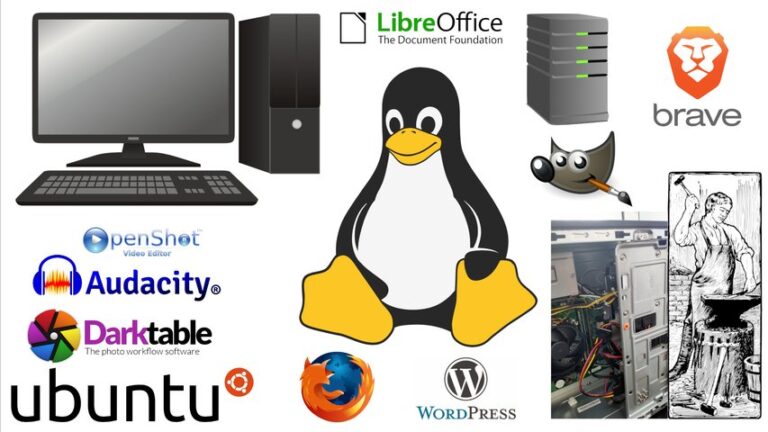Ubuntu Linux 20.04 on Dell Inspiron 15 (3000) Dual Boot
Background
Ubuntu Linux is a modern and polished version of a personal computer desktop that is free to download at ubuntu.com. There are many reasons to use the Ubuntu linux desktop, but a very important one is that it will run well on older computers that will no longer run Windows 10. This is a description of my experience updgrading a dual-boot laptop computer to Ubuntu 20.04.

Installation
The finished product is shown above. I had previously followed the instructions on the Dell website for Installing Ubuntu Dual boot with Windows. Note that when you do this, the default is for the computer to boot into linux. You need to select the “Windows Boot” option when starting up the computer to work in Windows. The graphics, sound and WIFI worked “out of box” for me when I installed the third party software. (If your Dell Inspiron will not boot to the Ubuntu disc/drive, you can use the F12 key for a one-time boot menu).
- Download the ISO version you want and burn it to a DVD
- There are a couple of choices to customize your language and keyboard.
- On the screen “Updates and Other Software” I recommend you check the box for “Install third party software for graphics and hardware”, to increase you chances of all the hardware being supported.
- For a first-time intallation, you can probably accept the defaults and continue. I will describe some of the details of an upgrade procedure, where the choices had some ambiguous wording to them, IMHO.
UPGRADE NOTES: As I’ll describe below, I actually upgraded twice, and since both methods worked, I’ll tell you the easier one first. On the next-to-last screen (you can tell by the bullet points at the bottom), there is some language similar to “Upgrade Ubuntu 18.04 and 20.04, or REINSTALL 20.04”. On a dual-boot computer, this can make someone hesitant because while it says your personal files are being saved, it says “system wide settings will be cleared”.
I did some research and, even though I’ve been using Ubuntu since 2004, I didn’t know you can upgrade the software while keeping your personal files, even without a separate /home partition, as described in the Ubuntu Help Page. So, the installation tells you AFTER you choose the “Install Now” button, via a popup, exactly which partition will be formatted for the upgrade. Only by inference do you really know that the Windows partitions will be untouched! Note to self: Use gparted in your existing install to check which partition linux is installed on BEFORE doing an upgrade for peace of mind.

Above is what it looks like when you run gparted OR when you choose “something else” from the “Installation Type” screen during the Ubuntu installation. The first time I installed Ubuntu 20.04 I used this method, formatted the only ext4 partition and did a fresh install (AFTER backing up all my files). This turned out to be unecessary, as described above.
Ubuntu Gnome Desktop Experience
I have used Linux desktop software almost full time since before 2004. I always preferred Gnome over KDE. I can see some appeal to the new version of Gnome. There are a lot of ways to navigate around your tasks/activities with your keyboard. There is a nice integration of your online accounts within the desktop. The resources required are significantly less than Windows 10. Office and graphics programs seem to run pretty snappy, even on a computer more than five years old. So, my impression of Gnome is positive and I would “recommend to a friend”.
The trouble I have with the current Gnome desktop is how much of the customization is taken out and put in “Extensions” that have their own framework and and installation method. By the time I got all the settings I wanted installed with Extensions, the desktop froze up. There was also one extension “stuck” in the taskbar that said “install ation required”, failed on attempting an installation, and had no clear way to get rid of it.

Ubuntu MATE Desktop Experience
Update. I edited out the section that said I used the MATE desktop. I really liked it a lot but the amount of crashes that came from the MATE-specific part of the system became higher than anything I wanted to be concerned with. I like the MATE interface better than the default Gnome interface, but the MATE project seems to be developed by a very small team(?) In any case, I’ve ended up trying to use the default settings as much as possible to reduce the amount of add-ons = things that can go wrong. After a few tweaks I’m happy with the gnome desktop and I like it a lot more than Windows.
Summary
I’ve been using a linux desktop full-time since at least 2004, so I obviously prefer it over the Windows environment. The feature of multiple virtual desktops (workspaces) really helps me organize my work. The OS runs smoothly on older hardware and maintaining software is extremely simple because the vast majority of it is maintained in a central repository. If you must run a Windows or Mac machine, consider making your second computer a linux desktop. You can test out the software without installing anything by burning a disk/thumbdrive and selecting the “Try Ubuntu” option at startup. Enjoy.



